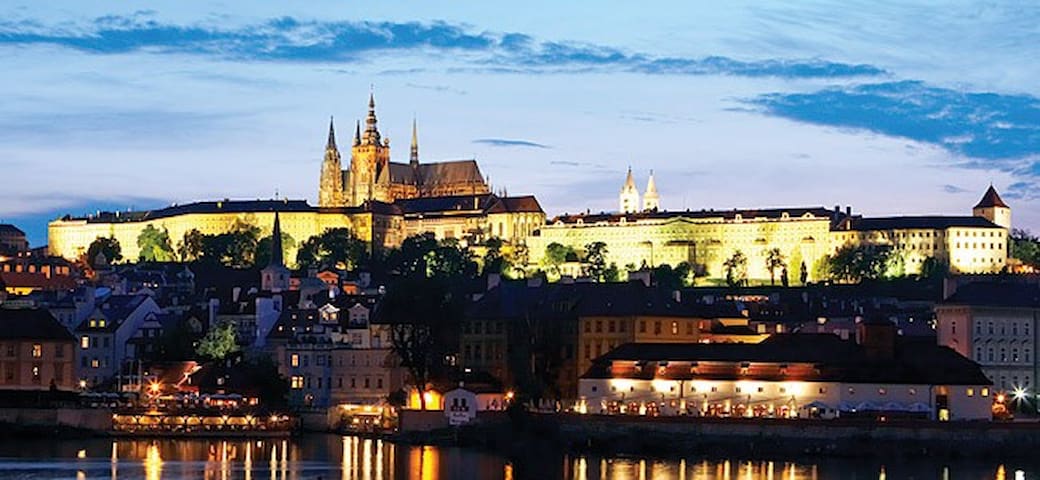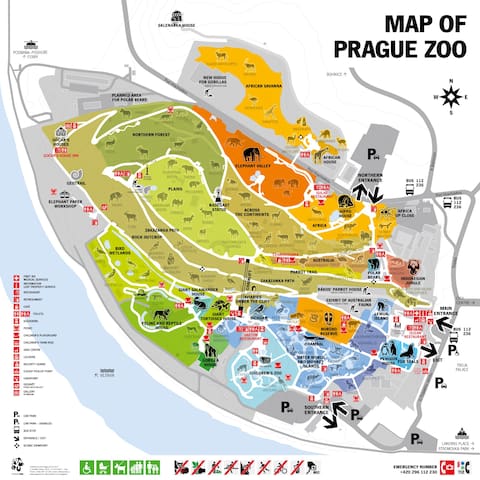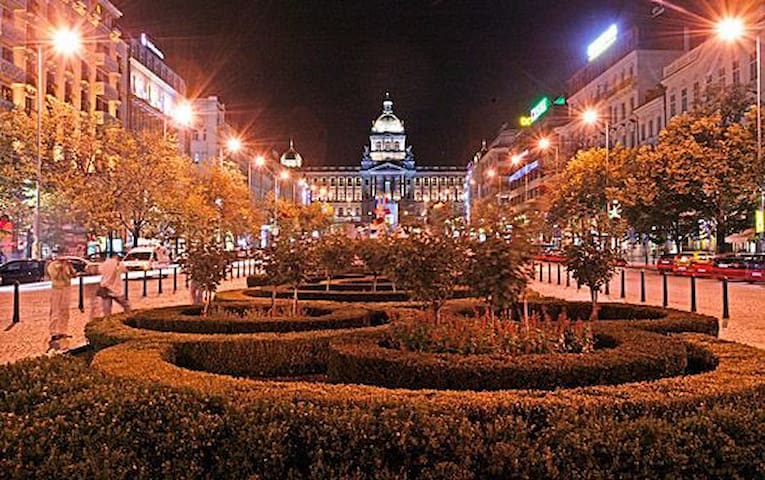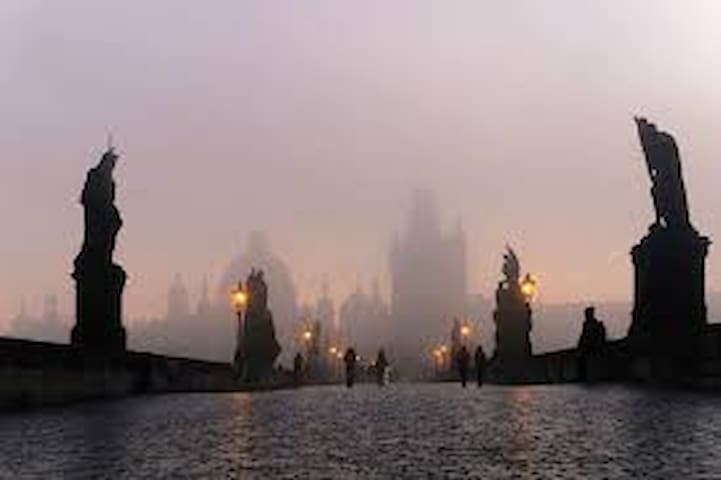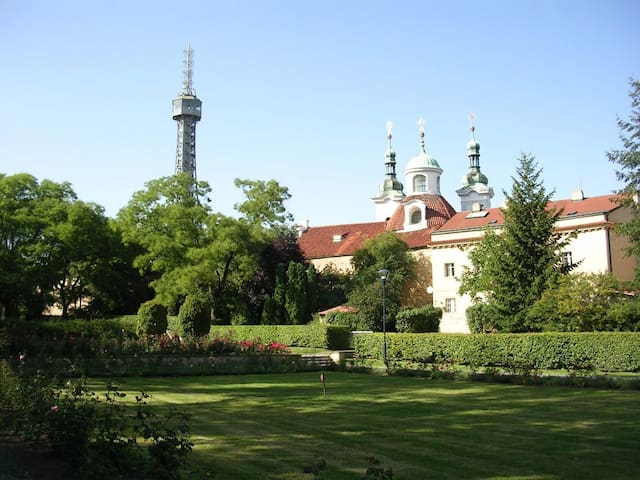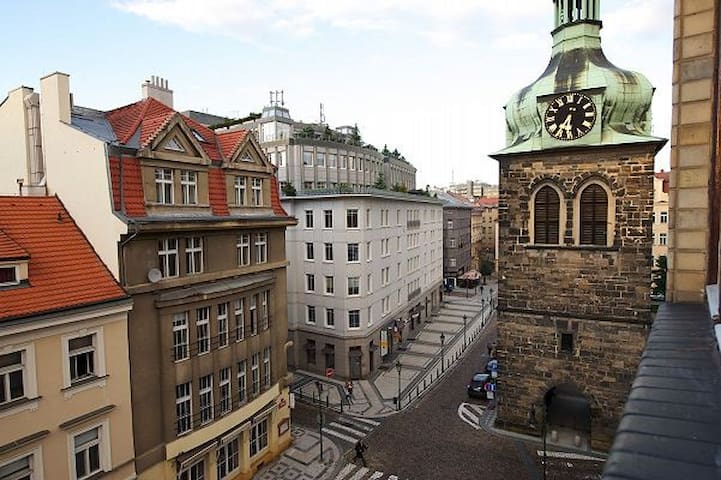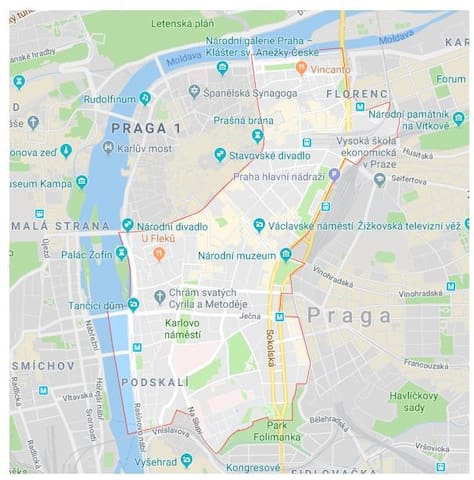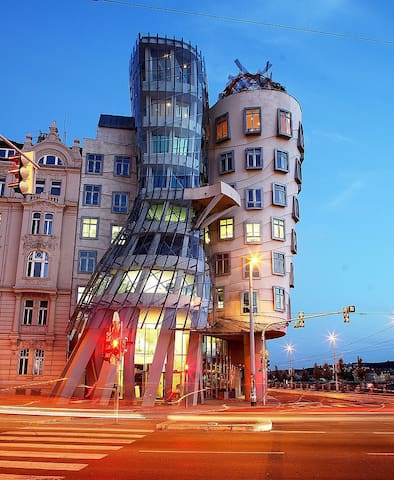Visite turistiche
Prague Castle has been an important symbol of the Czech state for more than a thousand years. It was founded in the 9th century and became the seat of Czech rulers and later presidents. The castle, one of the largest complexes in the world, is made up of historical palaces, offices, church and fortification buildings, gardens and picturesque spots. It covers an area of 45 hectares. The panoramic view of Prague Castle is one of the most spectacular in the world. - ADMISSION: tickets are valid for 2 days
Circuit A
St Vitus Cathedral, Old Royal Palace, exhibition The Story of Prague Castle, St George's Basilica, Golden Lane with Daliborka Tower, Powder Tower, Rosenberg Palace
Full 350 CZK - reduced 175 CZK - family 700 CZK
Circuit B
St Vitus Cath., Old Royal Palace, St George's Basilica, Golden Lane with Daliborka Tower
Full 250 CZK - reduced 125 CZK - family 500 CZK
More information to https://www.hrad.cz/
------------------------------------------------------------------------------------------------------------
Château de Prague a été un important symbole de l'Etat tchèque depuis plus de mille ans. Elle a été fondée au 9ème siècle et devint le siège des souverains tchèques et présidents plus tard. Le château, l'un des plus grands complexes dans le monde, est composé de palais historiques, des bureaux, des bâtiments d'église et de fortification, des jardins et des sites pittoresques. Il couvre une superficie de 45 hectares. La vue panoramique sur le château de Prague est l'une des plus spectaculaires dans le monde. - ADMISSION: billets sont valables pour 2 jours
Circuit A
Cathéd St Vitus, Vieux palais royal, exposition L'histoire du Château de Prague, la Basilique Saint-George, Golden Lane avec Daliborka Tour, Tour Poudrière, Rosenberg Palais
Plein 350 CZK - 175 CZK réduite - famille 700 CZK
Circuit B
St Vitus Cath., Vieux palais royal, la basilique Saint-George, Golden Lane avec Daliborka Tower
Plein 250 CZK - 125 CZK réduite - famille 500 CZK
Plus d'informations à https://www.hrad.cz/
------------------------------------------------------------------------------------------------------------
Die Prager Burg ist seit mehr als tausend Jahren ein wichtiges Symbol des tschechischen Staates. Es wurde im 9. Jahrhundert und wurde zum Sitz der böhmischen Herrscher und später Präsidenten gegründet. Das Schloss, einer der größten Komplexe in der Welt, ist der historischen Paläste, Büros, Kirche und Festung Gebäude, Gärten und malerischen Flecken gebildet. Es erstreckt sich über eine Fläche von 45 Hektar. Der Panoramablick auf die Prager Burg ist eine der spektakulärsten der Welt. - EINTRITT: Tickets sind gültig für 2 Tage
Schaltung A
St.-Veits-Dom, Alter Königspalast , Ausstellung Die Geschichte der Prager Burg, St.-Georgs-Basilika, Goldenes Gässchen mit Daliborturm, Pulverturm , Rosenberg Palace
Volle 350 CZK - 175 CZK reduziert - Familie 700 CZK
Schaltung B
St.-Veits-Cath., Old Royal Palace, St.-Georgs-Basilika, Goldenes Gässchen mit Daliborturm
Volle 250 CZK - 125 CZK reduziert - Familie 500 CZK
Weitere Informationen zu https://www.hrad.cz/
2060 (рекомендации местных жителей)
Пражский град
Prague Castle has been an important symbol of the Czech state for more than a thousand years. It was founded in the 9th century and became the seat of Czech rulers and later presidents. The castle, one of the largest complexes in the world, is made up of historical palaces, offices, church and fortification buildings, gardens and picturesque spots. It covers an area of 45 hectares. The panoramic view of Prague Castle is one of the most spectacular in the world. - ADMISSION: tickets are valid for 2 days
Circuit A
St Vitus Cathedral, Old Royal Palace, exhibition The Story of Prague Castle, St George's Basilica, Golden Lane with Daliborka Tower, Powder Tower, Rosenberg Palace
Full 350 CZK - reduced 175 CZK - family 700 CZK
Circuit B
St Vitus Cath., Old Royal Palace, St George's Basilica, Golden Lane with Daliborka Tower
Full 250 CZK - reduced 125 CZK - family 500 CZK
More information to https://www.hrad.cz/
------------------------------------------------------------------------------------------------------------
Château de Prague a été un important symbole de l'Etat tchèque depuis plus de mille ans. Elle a été fondée au 9ème siècle et devint le siège des souverains tchèques et présidents plus tard. Le château, l'un des plus grands complexes dans le monde, est composé de palais historiques, des bureaux, des bâtiments d'église et de fortification, des jardins et des sites pittoresques. Il couvre une superficie de 45 hectares. La vue panoramique sur le château de Prague est l'une des plus spectaculaires dans le monde. - ADMISSION: billets sont valables pour 2 jours
Circuit A
Cathéd St Vitus, Vieux palais royal, exposition L'histoire du Château de Prague, la Basilique Saint-George, Golden Lane avec Daliborka Tour, Tour Poudrière, Rosenberg Palais
Plein 350 CZK - 175 CZK réduite - famille 700 CZK
Circuit B
St Vitus Cath., Vieux palais royal, la basilique Saint-George, Golden Lane avec Daliborka Tower
Plein 250 CZK - 125 CZK réduite - famille 500 CZK
Plus d'informations à https://www.hrad.cz/
------------------------------------------------------------------------------------------------------------
Die Prager Burg ist seit mehr als tausend Jahren ein wichtiges Symbol des tschechischen Staates. Es wurde im 9. Jahrhundert und wurde zum Sitz der böhmischen Herrscher und später Präsidenten gegründet. Das Schloss, einer der größten Komplexe in der Welt, ist der historischen Paläste, Büros, Kirche und Festung Gebäude, Gärten und malerischen Flecken gebildet. Es erstreckt sich über eine Fläche von 45 Hektar. Der Panoramablick auf die Prager Burg ist eine der spektakulärsten der Welt. - EINTRITT: Tickets sind gültig für 2 Tage
Schaltung A
St.-Veits-Dom, Alter Königspalast , Ausstellung Die Geschichte der Prager Burg, St.-Georgs-Basilika, Goldenes Gässchen mit Daliborturm, Pulverturm , Rosenberg Palace
Volle 350 CZK - 175 CZK reduziert - Familie 700 CZK
Schaltung B
St.-Veits-Cath., Old Royal Palace, St.-Georgs-Basilika, Goldenes Gässchen mit Daliborturm
Volle 250 CZK - 125 CZK reduziert - Familie 500 CZK
Weitere Informationen zu https://www.hrad.cz/
Travel to the zoo in a different way – on-board a motor cruiser or steamboat. Avoid traffic stress in the city and have a wonderful experience with your children. During the comfortable cruise you will have the opportunity to show your children an interesting view and Prague monuments and also enjoy refreshments.
The regular boat connection departs from the Rašín Embankment or from Čech Bridge and in 75 or 55 minutes respectively will take you to the dock on Císařský Island near the zoo.
In the same way you can enjoy the trip home and again embark from the dock on Císařský Island and cruise by boat back to the centre of Prague to Čech Bridge or to the Rašín Embankment.
706 (рекомендации местных жителей)
Пражский зоопарк
120/3 U Trojského zámkuTravel to the zoo in a different way – on-board a motor cruiser or steamboat. Avoid traffic stress in the city and have a wonderful experience with your children. During the comfortable cruise you will have the opportunity to show your children an interesting view and Prague monuments and also enjoy refreshments.
The regular boat connection departs from the Rašín Embankment or from Čech Bridge and in 75 or 55 minutes respectively will take you to the dock on Císařský Island near the zoo.
In the same way you can enjoy the trip home and again embark from the dock on Císařský Island and cruise by boat back to the centre of Prague to Čech Bridge or to the Rašín Embankment.
Very Good!
4 of 5
Today it is dominated by the National Museum (1885 – 1891) and Josef Václav Myslbek’s statue of the national patron St Wenceslas from 1912. The square was created during the founding of the New Town by Charles IV in 1348. This square is the commercial and administrative centre of the city as well as the site of important social and historical events. Here you'll find cinemas, theatres, banks, hotels, restaurants, dozens of small and large shops, and administrative centres.
808 (рекомендации местных жителей)
Wenceslas Square Terraces
841 Václavské nám.Very Good!
4 of 5
Today it is dominated by the National Museum (1885 – 1891) and Josef Václav Myslbek’s statue of the national patron St Wenceslas from 1912. The square was created during the founding of the New Town by Charles IV in 1348. This square is the commercial and administrative centre of the city as well as the site of important social and historical events. Here you'll find cinemas, theatres, banks, hotels, restaurants, dozens of small and large shops, and administrative centres.
Exeptional!
5 of 5
Prague’s oldest bridge was built to replace the Judith Bridge that had been badly damaged by floods in 1342. The Stone, or Prague, Bridge, called Charles Bridge since 1870, was begun in 1357 by Charles IV and was completed in 1402. The bridge is built of sandstone blocks, flanked at each end by fortified towers (Lesser Town Bridge Towers, Old Town Bridge Tower). From 1683 to 1928, 30 statues of saints were carved to decorate the bridge, the most famous of which is the statue of St John of Nepomuk.
--------------------------------------------------------------------------------------------------------------
Le plus vieux pont de Prague a été construit pour remplacer le pont Judith qui avait été gravement endommagée par les inondations en 1342. La pierre, ou Prague, le pont, appelé pont Charles depuis 1870, a été commencée en 1357 par Charles IV et a été achevée en 1402. Le pont est construit des blocs de grès, flanqué à chaque extrémité par des tours fortifiées (Lesser Town Bridge Towers, Old Town Bridge Tower). De 1683-1928, 30 statues de saints ont été sculptés pour décorer le pont, dont le plus célèbre est la statue de St Jean Népomucène.
--------------------------------------------------------------------------------------------------------------
Prag die älteste Brücke wurde gebaut, um die Judithbrücke ersetzen, die durch die Überschwemmungen in 1342. Der Stein stark beschädigt worden war, oder Prag, Brücke, genannt Karlsbrücke seit 1870, wurde im Jahre 1357 von Karl IV begonnen und wurde im Jahre 1402. Die Brücke abgeschlossen ist gebaut von Blöcken Sandstein , an jedem Ende flankiert von Türmen (Kleinseitner Brückentürme , Altstädter Brückenturm ). Von 1683 bis 1928 wurden 30 Heiligenstatuen geschnitzt, die Brücke zu dekorieren, die berühmteste davon ist die Statue des heiligen Johannes von Nepomuk.
--------------------------------------------------------------------------------------------------------------
Il più antico ponte di Praga è stata costruita per sostituire il ponte di Giuditta che era stato gravemente danneggiato dalle inondazioni nel 1342. The Stone, o Praga, Ponte, chiamato Ponte Carlo dal 1870, fu iniziata nel 1357 da Carlo IV e fu completata nel 1402. Il ponte è costruita in blocchi di pietra di sabbia, fiancheggiate ad ogni estremità da torri fortificate (Lesser Town Bridge Towers, Torre vecchia). Dal 1683-1928, 30 statue di santi furono scolpite per decorare il ponte, la più famosa delle quali è la statua di San Giovanni Nepomuceno.
1717 (рекомендации местных жителей)
Карлов мост
Karlův mostExeptional!
5 of 5
Prague’s oldest bridge was built to replace the Judith Bridge that had been badly damaged by floods in 1342. The Stone, or Prague, Bridge, called Charles Bridge since 1870, was begun in 1357 by Charles IV and was completed in 1402. The bridge is built of sandstone blocks, flanked at each end by fortified towers (Lesser Town Bridge Towers, Old Town Bridge Tower). From 1683 to 1928, 30 statues of saints were carved to decorate the bridge, the most famous of which is the statue of St John of Nepomuk.
--------------------------------------------------------------------------------------------------------------
Le plus vieux pont de Prague a été construit pour remplacer le pont Judith qui avait été gravement endommagée par les inondations en 1342. La pierre, ou Prague, le pont, appelé pont Charles depuis 1870, a été commencée en 1357 par Charles IV et a été achevée en 1402. Le pont est construit des blocs de grès, flanqué à chaque extrémité par des tours fortifiées (Lesser Town Bridge Towers, Old Town Bridge Tower). De 1683-1928, 30 statues de saints ont été sculptés pour décorer le pont, dont le plus célèbre est la statue de St Jean Népomucène.
--------------------------------------------------------------------------------------------------------------
Prag die älteste Brücke wurde gebaut, um die Judithbrücke ersetzen, die durch die Überschwemmungen in 1342. Der Stein stark beschädigt worden war, oder Prag, Brücke, genannt Karlsbrücke seit 1870, wurde im Jahre 1357 von Karl IV begonnen und wurde im Jahre 1402. Die Brücke abgeschlossen ist gebaut von Blöcken Sandstein , an jedem Ende flankiert von Türmen (Kleinseitner Brückentürme , Altstädter Brückenturm ). Von 1683 bis 1928 wurden 30 Heiligenstatuen geschnitzt, die Brücke zu dekorieren, die berühmteste davon ist die Statue des heiligen Johannes von Nepomuk.
--------------------------------------------------------------------------------------------------------------
Il più antico ponte di Praga è stata costruita per sostituire il ponte di Giuditta che era stato gravemente danneggiato dalle inondazioni nel 1342. The Stone, o Praga, Ponte, chiamato Ponte Carlo dal 1870, fu iniziata nel 1357 da Carlo IV e fu completata nel 1402. Il ponte è costruita in blocchi di pietra di sabbia, fiancheggiate ad ogni estremità da torri fortificate (Lesser Town Bridge Towers, Torre vecchia). Dal 1683-1928, 30 statue di santi furono scolpite per decorare il ponte, la più famosa delle quali è la statua di San Giovanni Nepomuceno.
Petřín (327 m) is a hill in the center of Prague, Czech Republic. It rises some 130 m above the left bank of the Vltava River. The hill, almost entirely covered with parks, is a favorite recreational area for the inhabitants of Prague. The hill (in German known as Laurenziberg) is featured prominently in Franz Kafka's early short story "Description of a Struggle" and briefly in Milan Kundera's novel The Unbearable Lightness of Being.
268 (рекомендации местных жителей)
Petřín
Petřín (327 m) is a hill in the center of Prague, Czech Republic. It rises some 130 m above the left bank of the Vltava River. The hill, almost entirely covered with parks, is a favorite recreational area for the inhabitants of Prague. The hill (in German known as Laurenziberg) is featured prominently in Franz Kafka's early short story "Description of a Struggle" and briefly in Milan Kundera's novel The Unbearable Lightness of Being.
This extensive park with grassy areas, mature trees, a colorful assortment of bushes planted on the hillsides, and a long plane tree-lined avenue provides not only a pleasant to sit and relax, but also unparalleled views of the city, especially from the Hanavský Pavilion - a unique cast-iron building with a restaurant. In the park you can spend your free time participating in sports, walking, picnicking or relaxing in the summer garden restaurant in the Letná chateau in its eastern part.
33 (рекомендации местных жителей)
Letna Park
This extensive park with grassy areas, mature trees, a colorful assortment of bushes planted on the hillsides, and a long plane tree-lined avenue provides not only a pleasant to sit and relax, but also unparalleled views of the city, especially from the Hanavský Pavilion - a unique cast-iron building with a restaurant. In the park you can spend your free time participating in sports, walking, picnicking or relaxing in the summer garden restaurant in the Letná chateau in its eastern part.
Exeptional!
5 of 5
The National Theatre in Prague is known as the alma mater of Czech opera, and as the national monument of Czech history and art. The National Theatre belongs to the most important Czech cultural institutions, with a rich artistic tradition, which helped to preserve and develop the most important features of the nation–the Czech language and a sense for a Czech musical and dramatic way of thinking.
524 (рекомендации местных жителей)
Национальный театр
2 NárodníExeptional!
5 of 5
The National Theatre in Prague is known as the alma mater of Czech opera, and as the national monument of Czech history and art. The National Theatre belongs to the most important Czech cultural institutions, with a rich artistic tradition, which helped to preserve and develop the most important features of the nation–the Czech language and a sense for a Czech musical and dramatic way of thinking.
Very Good!
4 of 5
Prague TV Tower is the highest building in Prague, remarkable 216 meters and its park called "Mahlerovy sady" is place full of experiences! So let's explore! Either way in the observatory at the height of 93 metres above the ground, or in the luxury restaurant that is located a little lower and last but not least in the park right below the tower.
646 (рекомендации местных жителей)
Водопад Хен-Уоллоу
1 Mahlerovy sadyVery Good!
4 of 5
Prague TV Tower is the highest building in Prague, remarkable 216 meters and its park called "Mahlerovy sady" is place full of experiences! So let's explore! Either way in the observatory at the height of 93 metres above the ground, or in the luxury restaurant that is located a little lower and last but not least in the park right below the tower.
Petrské náměstí is in the Nové Město district. It is a relatively small square that forms the natural centre of this northern part of Prague’s historical core. It has only proudly borne its present name since 1894, based on the Church of St. Peter located not far from the square in Petrská Street. The area was originally called “U sv. Petra” and was considerably larger. Leading to the square are a number of streets: Petrská, Zlatnická, Truhlářská, Soukenická, Barvířská and Lodecká. In the early 21st Century, the square was reconstructed, turning the parking lot in the middle into a luxurious pedestrian zone with benches. Five beautiful plane trees were also newly planted on the square.
Petrské náměstí
Petrské náměstí is in the Nové Město district. It is a relatively small square that forms the natural centre of this northern part of Prague’s historical core. It has only proudly borne its present name since 1894, based on the Church of St. Peter located not far from the square in Petrská Street. The area was originally called “U sv. Petra” and was considerably larger. Leading to the square are a number of streets: Petrská, Zlatnická, Truhlářská, Soukenická, Barvířská and Lodecká. In the early 21st Century, the square was reconstructed, turning the parking lot in the middle into a luxurious pedestrian zone with benches. Five beautiful plane trees were also newly planted on the square.
Le Guide ai Quartieri
Jewish Quarter and Museum
he Old Jewish Cemetery is among the oldest surviving Jewish burial grounds in the world and along with the Old-New Synagogue, it is the most important site in the Prague Jewish Town. The National Geographic magazine lists it among the top ten cemeteries to visit around the world.
PRICES from 300 czk to 480 czk for full ticket. http://www.jewishmuseum.cz/en/info/visit/
-------------------------------------------------------------------------------------
Le vieux cimetière juif est parmi les plus anciens survivants des cimetières juifs dans le monde et le long de la Synagogue Vieille-Nouvelle , il est le site le plus important dans la ville juive de Prague . Le magazine National Geographic énumère parmi les dix premiers cimetières à visiter dans le monde entier. Prix à partir de 300 CZK 480 CZK pour plein de billets. http://www.jewishmuseum.cz/en/info/visit/
-------------------------------------------------------------------------------------
Der alte jüdische Friedhof gehört zu den ältesten erhaltenen jüdischen Grabstätten in der Welt und zusammen mit der Altneusynagoge , es ist der wichtigste Ort in der Prager Judenstadt ist . Das National Geographic Magazin listet es unter den Top-Ten- Friedhöfe auf der ganzen Welt zu besuchen. Preise von 300 CZK bis 480 CZK für volle Ticket. http://www.jewishmuseum.cz/en/info/visit/
-------------------------------------------------------------------------------------
Il Vecchio Cimitero Ebraico è tra i più antichi sopravvissuti cimiteri ebraici in tutto il mondo e insieme con la Sinagoga Vecchio-Nuova , è il più importante sito nel quartiere ebraico di Praga . La rivista National Geographic lo elenca tra le prime dieci cimiteri da visitare in tutto il mondo . Prezzi a partire da 300 czk a 480 czk per intero del biglietto. http://www.jewishmuseum.cz/en/info/visit/
113 (рекомендации местных жителей)
Йозефов
Jewish Quarter and Museum
he Old Jewish Cemetery is among the oldest surviving Jewish burial grounds in the world and along with the Old-New Synagogue, it is the most important site in the Prague Jewish Town. The National Geographic magazine lists it among the top ten cemeteries to visit around the world.
PRICES from 300 czk to 480 czk for full ticket. http://www.jewishmuseum.cz/en/info/visit/
-------------------------------------------------------------------------------------
Le vieux cimetière juif est parmi les plus anciens survivants des cimetières juifs dans le monde et le long de la Synagogue Vieille-Nouvelle , il est le site le plus important dans la ville juive de Prague . Le magazine National Geographic énumère parmi les dix premiers cimetières à visiter dans le monde entier. Prix à partir de 300 CZK 480 CZK pour plein de billets. http://www.jewishmuseum.cz/en/info/visit/
-------------------------------------------------------------------------------------
Der alte jüdische Friedhof gehört zu den ältesten erhaltenen jüdischen Grabstätten in der Welt und zusammen mit der Altneusynagoge , es ist der wichtigste Ort in der Prager Judenstadt ist . Das National Geographic Magazin listet es unter den Top-Ten- Friedhöfe auf der ganzen Welt zu besuchen. Preise von 300 CZK bis 480 CZK für volle Ticket. http://www.jewishmuseum.cz/en/info/visit/
-------------------------------------------------------------------------------------
Il Vecchio Cimitero Ebraico è tra i più antichi sopravvissuti cimiteri ebraici in tutto il mondo e insieme con la Sinagoga Vecchio-Nuova , è il più importante sito nel quartiere ebraico di Praga . La rivista National Geographic lo elenca tra le prime dieci cimiteri da visitare in tutto il mondo . Prezzi a partire da 300 czk a 480 czk per intero del biglietto. http://www.jewishmuseum.cz/en/info/visit/
The New Town (Czech: Nové Město) is a quarter in the city of Prague in the Czech Republic. New Town is the youngest and largest of the five independent (from the Middle Ages until 1784) towns that today comprise the historic center of modern Prague. New Town was founded in 1348 by Charles IV just outside the city walls to the east and south of the Old Town and encompassed an area of 7.5 km²; about three times the size of the Old Town. The population of Prague in 1378 was well over 40,000, perhaps as much as twice that, making it the 4th most populated city north of the Alps and, by area, the 3rd largest city in Europe. Although New Town can trace its current layout to its construction in the 14th century, only few churches and administrative buildings from this time survive. There are many secular and educational buildings in New Town, but also especially magnificent gothic and baroque churches. These nevertheless are not the main drawing points for tourists. New Town's most famous landmark is Wenceslas Square, which was originally built as a horsemarket and now functions as a center of commerce and tourism. In the 15th century, the Novoměstská radnice, or New Town Hall, was the site of the first of the three defenestrations of Prague.
8 (рекомендации местных жителей)
Нью-Таун
The New Town (Czech: Nové Město) is a quarter in the city of Prague in the Czech Republic. New Town is the youngest and largest of the five independent (from the Middle Ages until 1784) towns that today comprise the historic center of modern Prague. New Town was founded in 1348 by Charles IV just outside the city walls to the east and south of the Old Town and encompassed an area of 7.5 km²; about three times the size of the Old Town. The population of Prague in 1378 was well over 40,000, perhaps as much as twice that, making it the 4th most populated city north of the Alps and, by area, the 3rd largest city in Europe. Although New Town can trace its current layout to its construction in the 14th century, only few churches and administrative buildings from this time survive. There are many secular and educational buildings in New Town, but also especially magnificent gothic and baroque churches. These nevertheless are not the main drawing points for tourists. New Town's most famous landmark is Wenceslas Square, which was originally built as a horsemarket and now functions as a center of commerce and tourism. In the 15th century, the Novoměstská radnice, or New Town Hall, was the site of the first of the three defenestrations of Prague.
Offerta gastronomica
The Dancing House (Czech: Tančící dům), or Fred and Ginger, is the nickname given to the Nationale-Nederlanden building on the Rašínovo nábřeží (Rašín Embankment) in Prague, Czech Republic. It was designed by the Croatian-Czech architect Vlado Milunić in cooperation with Canadian-American architect Frank Gehry on a vacant riverfront plot. The building was designed in 1992 and completed in 1996.
749 (рекомендации местных жителей)
Танцующий дом
6 Jiráskovo nám.The Dancing House (Czech: Tančící dům), or Fred and Ginger, is the nickname given to the Nationale-Nederlanden building on the Rašínovo nábřeží (Rašín Embankment) in Prague, Czech Republic. It was designed by the Croatian-Czech architect Vlado Milunić in cooperation with Canadian-American architect Frank Gehry on a vacant riverfront plot. The building was designed in 1992 and completed in 1996.

